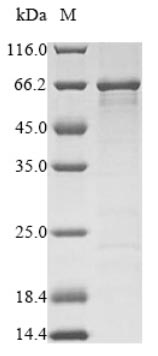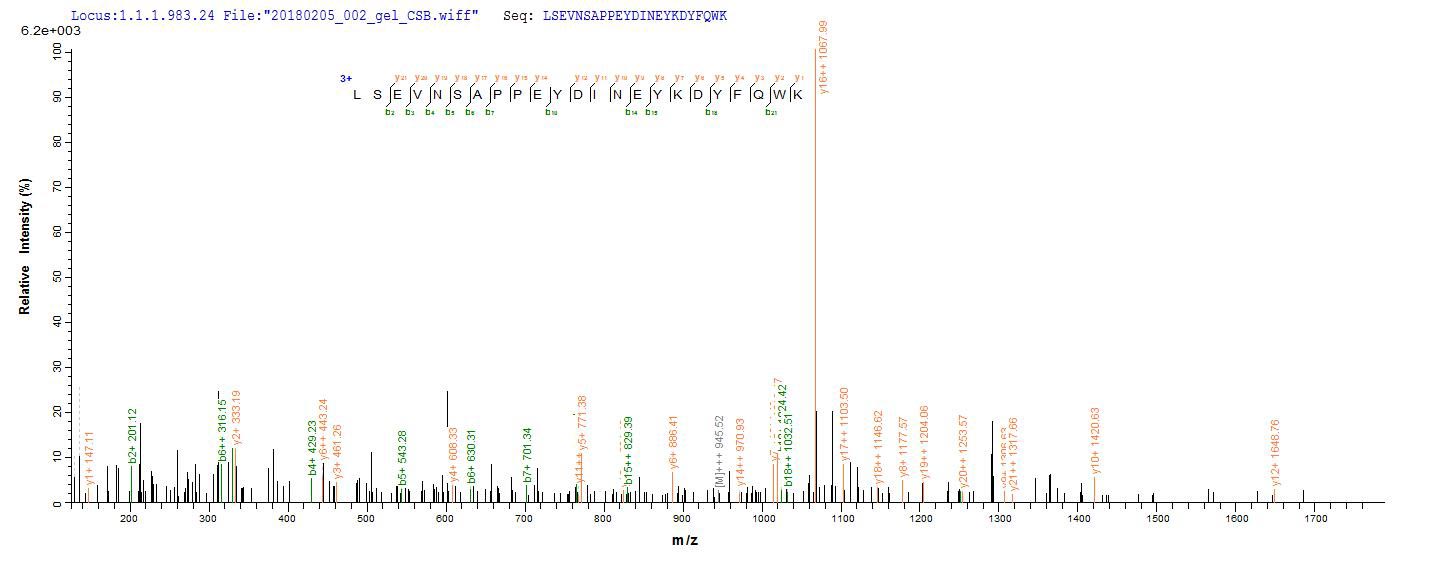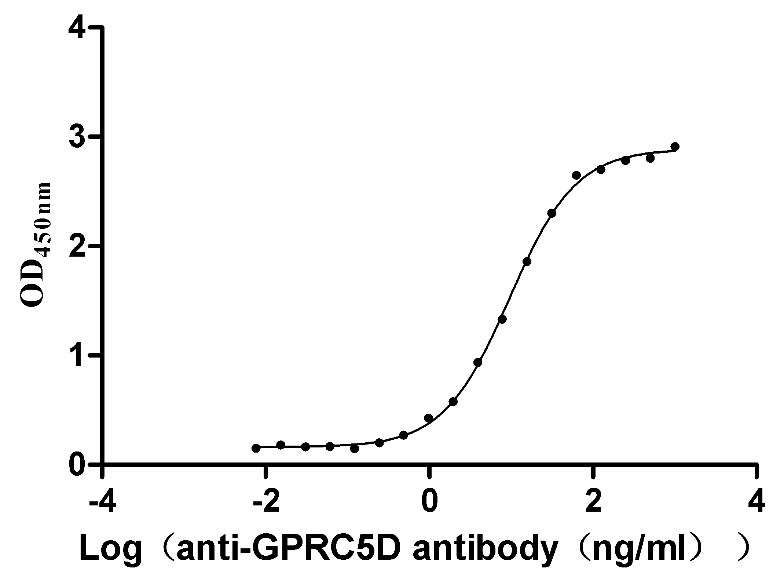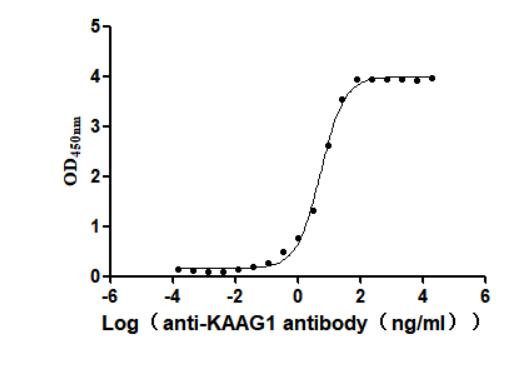Recombinant Clostridium botulinum Botulinum neurotoxin type F (botF), partial
In Stock-
中文名称:Recombinant Clostridium botulinum Botulinum neurotoxin type F(botF),partial
-
货号:CSB-EP341192CLQ
-
规格:¥2328
-
图片:
-
(Tris-Glycine gel) Discontinuous SDS-PAGE (reduced) with 5% enrichment gel and 15% separation gel.
-
Based on the SEQUEST from database of E.coli host and target protein, the LC-MS/MS Analysis result of CSB-EP341192CLQ could indicate that this peptide derived from E.coli-expressed Clostridium botulinum botF.
-
Based on the SEQUEST from database of E.coli host and target protein, the LC-MS/MS Analysis result of CSB-EP341192CLQ could indicate that this peptide derived from E.coli-expressed Clostridium botulinum botF.
-
-
其他:
产品详情
-
纯度:Greater than 90% as determined by SDS-PAGE.
-
基因名:botF
-
Uniprot No.:
-
别名:botFBotulinum neurotoxin type F; BoNT/F; Bontoxilysin-F) [Cleaved into: Botulinum neurotoxin F light chain; LC; EC 3.4.24.69); Botulinum neurotoxin F heavy chain; HC)]
-
种属:Clostridium botulinum
-
蛋白长度:Partial( Botulinum neurotoxin F light chain)
-
来源:E.coli
-
分子量:53.6kDa
-
表达区域:1-436aa
-
氨基酸序列MPVAINSFNYNDPVNDDTILYMQIPYEEKSKKYYKAFEIMRNVWIIPERNTIGTNPSDFDPPASLKNGSSAYYDPNYLTTDAEKDRYLKTTIKLFKRINSNPAGKVLLQEISYAKPYLGNDHTPIDEFSPVTRTTSVNIKLSTNVESSMLLNLLVLGAGPDIFESCCYPVRKLIDPDVVYDPSNYGFGSINIVTFSPEYEYTFNDISGGHNSSTESFIADPAISLAHELIHALHGLYGARGVTYEETIEVKQAPLMIAEKPIRLEEFLTFGGQDLNIITSAMKEKIYNNLLANYEKIATRLSEVNSAPPEYDINEYKDYFQWKYGLDKNADGSYTVNENKFNEIYKKLYSFTESDLANKFKVKCRNTYFIKYEFLKVPNLLDDDIYTVSEGFNIGNLAVNNRGQSIKLNPKIIDSIPDKGLVEKIVKFCKSVIPRK
Note: The complete sequence including tag sequence, target protein sequence and linker sequence could be provided upon request. -
蛋白标签:N-terminal 6xHis-tagged
-
产品提供形式:Liquid or Lyophilized powder
Note: We will preferentially ship the format that we have in stock, however, if you have any special requirement for the format, please remark your requirement when placing the order, we will prepare according to your demand. -
缓冲液:Tris-based buffer,50% glycerol
-
储存条件:Store at -20°C/-80°C upon receipt, aliquoting is necessary for mutiple use. Avoid repeated freeze-thaw cycles.
-
保质期:The shelf life is related to many factors, storage state, buffer ingredients, storage temperature and the stability of the protein itself.
Generally, the shelf life of liquid form is 6 months at -20°C/-80°C. The shelf life of lyophilized form is 12 months at -20°C/-80°C. -
货期:3-7 business days
-
注意事项:Repeated freezing and thawing is not recommended. Store working aliquots at 4°C for up to one week.
-
Datasheet & COA:Please contact us to get it.
相关产品
靶点详情
-
功能:Botulinum toxin causes flaccid paralysis by inhibiting neurotransmitter (acetylcholine) release from the presynaptic membranes of nerve terminals of the eukaryotic host skeletal and autonomic nervous system, with frequent heart or respiratory failure. Precursor of botulinum neurotoxin F which may have 2 coreceptors; complex polysialylated gangliosides found on neural tissue and specific membrane-anchored proteins found in synaptic vesicles. Receptor proteins are exposed on host presynaptic cell membrane during neurotransmitter release, when the toxin heavy chain (HC) binds to them. Upon synaptic vesicle recycling the toxin is taken up via the endocytic pathway. When the pH of the toxin-containing endosome drops a structural rearrangement occurs so that the N-terminus of the HC forms pores that allows the light chain (LC) to translocate into the cytosol. Once in the cytosol the disulfide bond linking the 2 subunits is reduced and LC cleaves its target protein on synaptic vesicles, preventing their fusion with the cytoplasmic membrane and thus neurotransmitter release. Whole toxin only has protease activity after reduction, which releases LC. Requires complex eukaryotic host polysialogangliosides for full neurotoxicity. It is not clear whether a synaptic vesicle protein acts as its receptor; there is evidence for and against SV2 fulfilling this function.; Has proteolytic activity. After translocation into the eukaryotic host cytosol, inhibits neurotransmitter release by acting as a zinc endopeptidase that catalyzes the hydrolysis of the '60-Gln-|-Lys-61' bond of synaptobrevin-1/VAMP1 and the equivalent 'Gln-|-Lys' sites in VAMP2 and VAMP3. Cleaves the '48-Gln-|-Lys-49' bond of A.californica synaptobrevin (AC P35589).; Responsible for host epithelial cell transcytosis, host nerve cell targeting and translocation of light chain (LC) into host cytosol. Composed of 3 subdomains; the translocation domain (TD), and N-terminus and C-terminus of the receptor-binding domain (RBD). The RBD is responsible for the adherence of the toxin to the cell surface. It simultaneously recognizes 2 coreceptors; polysialated gangliosides and the receptor protein SV2A, SV2B and SV2C in close proximity on host synaptic vesicles; although not all evidence indicates these are the receptors. The N-terminus of the TD wraps an extended belt around the perimeter of the LC, protecting Zn(2+) in the active site; it may also prevent premature LC dissociation from the translocation channel and protect toxin prior to translocation. The TD inserts into synaptic vesicle membrane to allow translocation into the host cytosol.
-
亚细胞定位:[Botulinum neurotoxin type F]: Secreted.; [Botulinum neurotoxin F light chain]: Secreted. Host cytoplasm, host cytosol.; [Botulinum neurotoxin F heavy chain]: Secreted. Host cell junction, host synapse, host presynaptic cell membrane. Host cytoplasmic vesicle, host secretory vesicle, host synaptic vesicle membrane; Multi-pass membrane protein.
-
蛋白家族:Peptidase M27 family
Most popular with customers
-
Recombinant Macaca mulatta Microtubule-associated protein tau (MAPT) (Active)
Express system: Mammalian cell
Species: Macaca mulatta (Rhesus macaque)
-
Recombinant Human G-protein coupled receptor family C group 5 member D (GPRC5D)-VLPs (Active)
Express system: Mammalian cell
Species: Homo sapiens (Human)
-
Recombinant Human Claudin-6 (CLDN6)-VLPs (Active)
Express system: Mammalian cell
Species: Homo sapiens (Human)
-
Recombinant Human Microtubule-associated protein tau (MAPT) (Active)
Express system: Mammalian cell
Species: Homo sapiens (Human)
-
Recombinant Human Claudin-3 (CLDN3)-VLPs (Active)
Express system: Mammalian cell
Species: Homo sapiens (Human)
-
Recombinant Human C-type lectin domain family 4 member C (CLEC4C), partial (Active)
Express system: Mammalian cell
Species: Homo sapiens (Human)
-
Recombinant Human Kidney-associated antigen 1(KAAG1) (Active)
Express system: Baculovirus
Species: Homo sapiens (Human)







-AC1.jpg)
-AC1.jpg)













